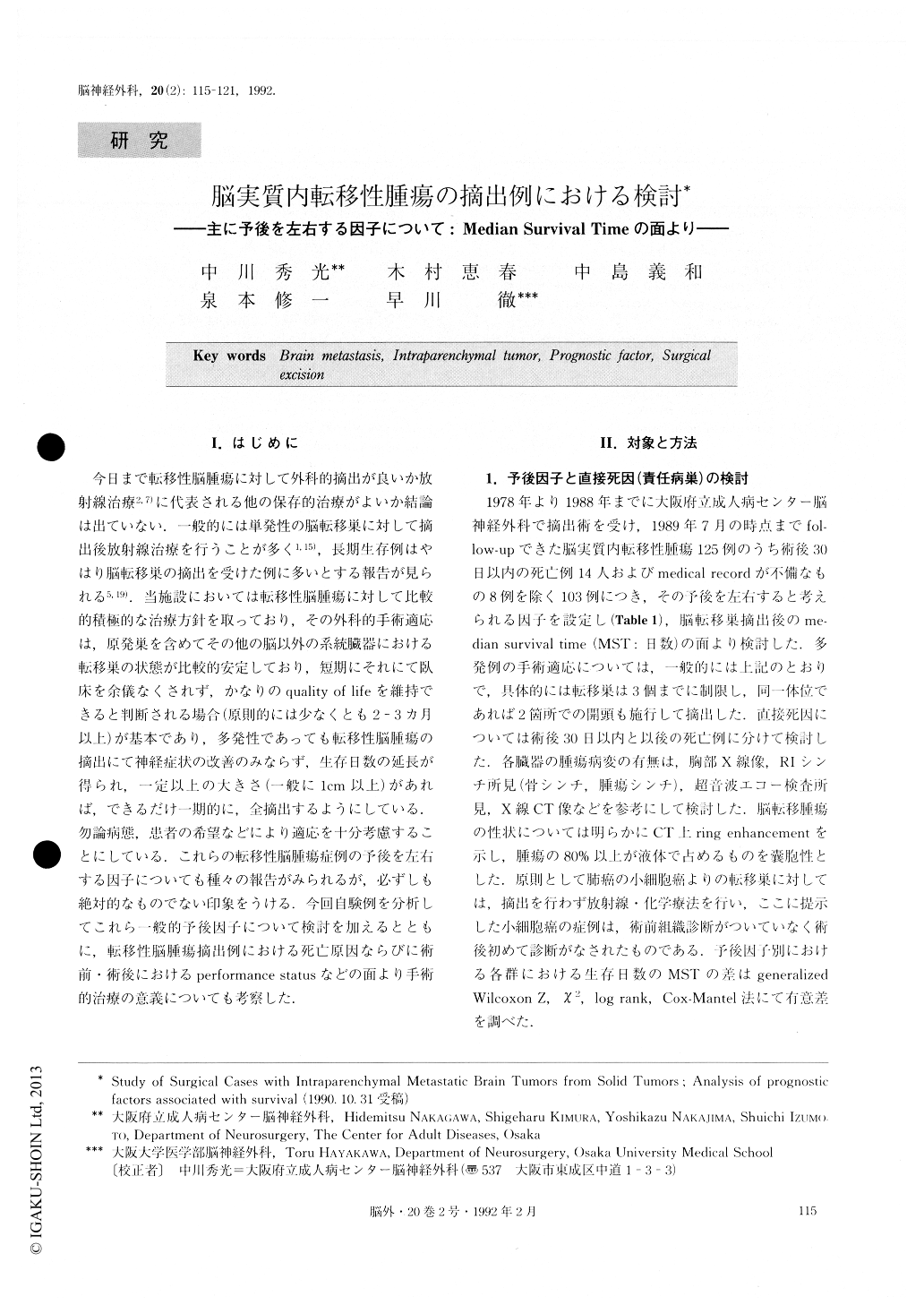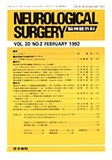Japanese
English
- 有料閲覧
- Abstract 文献概要
- 1ページ目 Look Inside
I.はじめに
今日まで転移性脳腫瘍に対して外科的摘出が良いか放射線治療2,7)に代表される他の保存的治療がよいか結論は川ていない.一般的には単発性の脳転移巣に対して摘出後放射線治療を行うことが多く1,15),長期生存例はやはり脳転移巣の摘出を受けた例に多いとする報告が見られる5,19).当施設においては転移性脳腫瘍に対して比較的積極的な治療方針を取っており,その外科的手術適応は,原発巣を含めてその他の脳以外の系統臓器における転移巣の状態が比較的安定しており,煙期にそれにて臥床を余儀なくされず,かなりのquality of lifeを維持できると判断される場合(原則的には少なくとも2-3カ月以上)が基本であり,多発性であっても転移性脳腫瘍の摘出にて神経症状の改善のみならず,生存日数の延長が得られ,一定以上の大きさ(一般に1cm以上)があれば,できるだけ一期的に,金摘出するようにしている.勿論病態,患者の希望などにより適応を十分考慮することにしている.これらの転移性脳腫瘍症例の予後を左右する因子についても種々の報告がみられるが,必ずしも絶対的なものでない印象をうける.今回自験例を分析してこれら一般的予後因子について検討を加えるとともに,転移性脳腫瘍摘出例における死亡原因ならびに術前・術後におけるperformance statusなどの面より手術的治療の意義についても考察した.
One-hundred and twenty-five patients who had undergone surgery for intraparenchymal brain metasta-sis (solitary or multiple) at The Center for Adult Dis-eases, Osaka, between 1978 and 1988, who had been followed-up until July, 1989 were reviewed. Statistical evaluation of various prognostic factors was performed on the basis of the median survival time after tumor re-moval for 103 patients after excluding 14 patients who died within 30 days after tumor removal and 8 patients with incomplete medical records. The lesions responsi-ble for death, which included metastasis, carcinogenic tumor in organs other than the brain and treatment-related lesion, and change in performance status after surgical resection as assessed by the score on the Kar-nofsky scale were also investigated to evaluate the effect of surgical therapy. The overall median survival time of the series was 6.0 months, with a 1-year surviv-al rate of 18%. Favorable prognostic variables showing statistical significance included a preoperative perform-ance status above 40% on the Karnofsky scale and the presence of only brain metastasis, without any metasta-tic deposits or primary lesions outside the brain. Other favorable prognostic factors, which were not significant on the basis of statistical tests, were an age of under 65, surgical excision of the primary lesion, absence of a primary lesion, absence of metastatic lesions, solid type of tumor, supratentorial location of the tumor, and the use of adjuvant therapy if the tumor is not resistant to chemotherapy and/or radiotherapy. The factor of the free interval was not found to be significant. Regarding the cause of death, only 26% of nonsurvivors died of the brain lesion itself; 69% died of systemic cancer out-side the brain. Performance status was improved by surgical excision in 58%, unchanged in 29%, and worse 'in only 13%. These data suggest that positive treatment for local lesions, combined with systemic treatment for advanced original cancer, may relieve patients from agony, may improve performance status, and may pro-long the quality of life, significantly. In general, the in-dication for surgical treatment of brain metastasis is a single and solitary tumor. However, even in multiple metastasis, surgical removals might sometimes produce a good result.

Copyright © 1992, Igaku-Shoin Ltd. All rights reserved.


